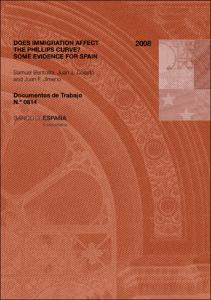Registro completo de metadatos
| Campo DC | Valor |
|---|---|
| dc.contributor.author | Bentolila Chocrón, Samuel |
| dc.contributor.author | Dolado Lobregad, Juan José |
| dc.contributor.author | Jimeno, Juan F. |
| dc.date.accessioned | 2019-08-10T17:52:43Z |
| dc.date.available | 2019-08-10T17:52:43Z |
| dc.date.issued | 2008-06-24 |
| dc.identifier.issn | ISSN: 0213-2710 (en papel) |
| dc.identifier.issn | ISSN: 1579-8666 (en línea) |
| dc.identifier.uri | https://repositorio.bde.es/handle/123456789/6943 |
| dc.description | Incluye bibliografía |
| dc.description.abstract | The Phillips curve has flattened in Spain over 1995-2006: unemployment has fallen by 15 percentage points, with roughly constant inflation. This change has been more pronounced than elsewhere. We argue that this stems from the immigration boom in Spain over this period. We show that the New Keynesian Phillips curve is shifted by immigration if natives' and immigrants' labor supply or bargaining power differ. Estimation of the curve for Spain indicates that the fall in unemployment since 1995 would have led to an annual increase in inflation of 2.5 percentage points if it had not been largely offset by immigration |
| dc.format.extent | 51 p. : formulas, graf., tab. |
| dc.language.iso | en |
| dc.publisher | Banco de España |
| dc.relation.ispartof | Documentos de Trabajo / Banco de España, 0814 |
| dc.rights | Reconocimiento-NoComercial-CompartirIgual 4.0 Internacional (CC BY-NC-SA 4.0) |
| dc.rights | In Copyright - Non Commercial Use Permitted |
| dc.rights.uri | https://creativecommons.org/licenses/by-nc-sa/4.0/deed.es_ES |
| dc.rights.uri | http://rightsstatements.org/vocab/InC-NC/1.0/ |
| dc.subject | Phillips curve |
| dc.subject | Immigration |
| dc.title | Does immigration affect the Phillips Curve? : some evidence for Spain |
| dc.type | Documento de trabajo |
| dc.identifier.bdebib | 000206736 |
| dc.identifier.bdepub | DTRA-200814-eng |
| dc.subject.bde | Relaciones laborales |
| dc.subject.bde | Mercado de trabajo |
| dc.publisher.bde | Madrid : Banco de España, 2008 |
| dc.subject.jel | E31 |
| dc.subject.jel | J64 |












